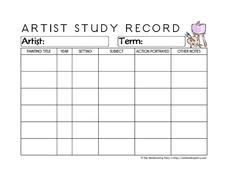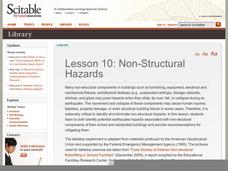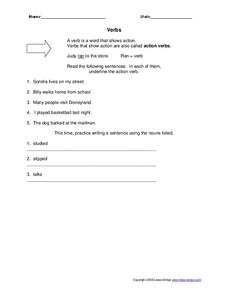Curated OER
Giving and Taking Directions
Learners identify the difference between commands and a declarative sentence. They complete a diagram with verbs, prepositions and numbers. They follow directions using a map and give directions to another location.
Curated OER
Giving and Taking Directions (Middle School)
Students describe the difference between a declarative sentence and a command. They complete a diagram verbs, prepositions and numbers. They follow directions on a map and create directions of their own to another location.
Curated OER
Classification in Action
Students work with a set of objects to set up both quantitative and qualitative classification systems. As a group, students follow an example to design and complete two classification systems using a set of objects provided. ...
Curated OER
Ready, Set, Action
Young scholars identify propaganda techniques used in commercials created by their classmates. In this active listening lesson, students use the provided scoring guide to evaluate commercials that their classmates made that feature...
Cornell University
Wasps and Ladybugs
Can a good bug ever become a bad bug? An elementary entomology resource explores what to do when too many ladybugs or too many bees are in your home and can become a problem.
It's About Time
Response Time
How fast are your reactions in the case of an emergency? Young scholars complete many activities including: time estimation, building a circuit, multiple reaction time experiments, and graphing.
Curated OER
World Literature: “The Wounded” By Lu Xinhua
“The Wounded,” the title story from a collection of stories about the Chinese Cultural Revolution (1977-78), is the central text in a World Literature unit examining choices. An anticipation guide, discussion topics, vocabulary list,...
Canadian Civil Liberties Education Trust
That’s Not Fair!
As part of a series of critical thinking exercises, kids consider issues of social justice, especially the factors that must be considered when trying to balance conflicting rights and freedoms.
Scholastic
Spring Is Sprung: Water Movement in Plants
Young scientists use food coloring and celery stalks to determine how water travels through plants.
Curated OER
Artist Study Record
What pieces of art have your learners studied so far? You'd certainly know if they had been using a record sheet! Each record page is reserved for one artist, and pupils can write in painting names and related information. Also included...
Center for Learning in Action
Challenge with Solids, Liquids, and Gases
There's a container for every matter—liquid, solid, and gas. Pupils design three different containers, each with the capability to hold one of the states of matter, and share their design with the class.
EngageNY
Solving Basic One-Variable Quadratic Equations
Help pupils to determine whether using square roots is the method of choice when solving quadratic equations by presenting a lesson that begins with a dropped object example and asks for a solution. This introduction to solving by square...
Curated OER
Express Yourself!
First graders examine positive ways to express their emotions. They act out a song to the tune of "London Bridge" and discuss different scenarios. After discussion, they complete a worksheet in which they circle the best action to take...
Curated OER
Experiment to Mimic the Digestive System
Biology lab technicians take a cheese sandwich apart as a demonstration of digestion. They record appearance and mass both before and after the process, which mimics chewing, acid action, and churning. Learners write their own lab...
Curated OER
Introduction to Drama
Introduce your class to drama! You cast each pupil as a different character from a story you have read. They are given a general outline of the scene, act out the scene multiple times, then discuss the weak and strong aspects of each...
Nature
Non-Structural Hazards
Buildings often have decorative components and furnishings that can pose a hazard during an earthquake. Learners examine the classroom for such non-structural features. They consider fictional scenarios and discuss what actions would be...
Curated OER
What Are You Doing?
Students use current time indicators while learning to talk about on-going action. In these vocabulary lessons, students works with power point presentations, games, flashcards, worksheets and video slides.
Curated OER
Pop Rockets
Pupils study Newton's Third Law of Motion which involves action and reaction. They discover what makes a rocket go and then design and construct a rocket that will launch the furthest using the pressure created by an antacid tablet...
Curated OER
Stock The Choc!
Students analyze their power as a consumer. They create their own campaign to urge the schools to stock fair trade products. They discuss their own petition forms and take action as needed.
Curated OER
Marine Debris Module
Students analyze issues related to the Hawaiian Islands. They examine previous studies by real scientists and create their own study. They use the results of their study to take action in their local community.
Curated OER
Darfur Now Lesson One: Introduction to Darfur Now
Students view a brief film and define vocabulary terms related to genocide. In this civics instructional activity, students discuss motivations of people to take action against the crisis in Darfur. Students write responses to the film...
Curated OER
Verbs
In this verbs worksheet, students underline the action verb in 5 sentences, write 3 nouns in a complete sentence and circle the multiple choice answer in 5 sentences that tells whether a sentence is happening in the past, present or...
Curated OER
I WILL NOT HEAR THAT PLAY: PERFORMING A DUMB SHOW
Learners perform a "dumb show" based on a short passage from either A Midsummer Night's Dream or King Lear. This technique allows students to explain the action taking place on stage and the variety of different ways that action can be...
Curated OER
Planting Seeds of Philanthropy
Students explore the importance of maintaining a democracy through philanthropic actions. In this character education lesson, students discover what the Japanese internment camps were, and why they were an infringement on personal...

























